Trees and Crops Arrangement in the Agroforestry System Based on Slope Units to Control Landslide Reactivation on Volcanic Foot Slopes in Java, Indonesia
Abstract
:1. Introduction
2. Materials and Methods
3. Results
3.1. Zones of the Landslide Slope Units
3.2. Types and Intensity of the Geomorphological Process
3.3. Inventory of Recent Vegetation Cover
4. Discussion
5. Conclusions
Author Contributions
Funding
Acknowledgments
Conflicts of Interest
References
- Menezes, A.S.; Alencar, T.L.; Júnior, R.N.A.; Toma, R.S.; Romero, R.E.; Costa, M.C.G.; Mota, J.C.A. Functionality of the porous network of Bt horizons of soils with and without cohesive character. Geoderma 2018. [Google Scholar] [CrossRef]
- Vanwalleghem, T.; Poesen, J.; McBratney, A.; Deckers, J. Spatial variability of soil horizon depth in natural loess-derived soils. Geoderma 2010. [Google Scholar] [CrossRef]
- Zhang, Y.Y.; Wu, W.; Liu, H. Factors affecting variations of soil pH in different horizons in hilly regions. PLoS ONE 2019. [Google Scholar] [CrossRef] [PubMed]
- Carey, J.M.; Moore, R.; Petley, D.N. Patterns of movement in the Ventnor landslide complex, Isle of Wight, Southern England. Landslides 2015. [Google Scholar] [CrossRef] [Green Version]
- Abd-Elmabod, S.K.; Bakr, N.; Muñoz-Rojas, M.; Pereira, P.; Zhang, Z.; Cerdà, A.; Jones, L. Assessment of soil suitability for improvement of soil factors and agricultural management. Sustainability 2019, 11, 1588. [Google Scholar] [CrossRef] [Green Version]
- Van Hemelryck, H.; Govers, G.; van Oost, K.; Merckx, R. Evaluating the impact of soil redistribution on the in situ mineralization of soil organic carbon. Earth Surf. Process. Landf. 2011. [Google Scholar] [CrossRef]
- Doetterl, S.; Cornélis, J.T.; Six, J.; Bodé, S.; Opfergelt, S.; Boeckx, P.; Van Oost, K. Soil redistribution and weathering controlling the fate of geochemical and physical carbon stabilization mechanisms in soils of an eroding landscape. Biogeosciences 2015. [Google Scholar] [CrossRef] [Green Version]
- Sartohadi, J.; Pulungan, N.A.H.J.; Nurudin, M.; Wahyudi, W. The ecological perspective of landslides at soils with high clay content in the middle bogowonto watershed, central Java, Indonesia. Appl. Environ. Soil Sci. 2018. [Google Scholar] [CrossRef] [Green Version]
- Perera, E.N.C.; Jayawardana, D.T.; Jayasinghe, P.; Bandara, R.M.S.; Alahakoon, N. Direct impacts of landslides on socio-economic systems: A case study from Aranayake, Sri Lanka. Geoenviron. Disasters 2018. [Google Scholar] [CrossRef]
- Craswell, E.T.; Sajjapongse, A.; Howlett, D.J.B.; Dowling, A.J. Agroforestry in the management of sloping lands in Asia and the Pacific. Agrofor. Syst. 1997. [Google Scholar] [CrossRef]
- Montagnini, F.; Metzel, R. Integrating Landscapes: Agroforestry for Biodiversity Conservation and Food Sovereignty; Springer: Cham, Switzerland, 2017. [Google Scholar]
- Nair, P.K.R. Agroforestry-The Future of Global Land Use Advances in Agroforestry; Springer: Dordrecht, The Netherlands, 2012. [Google Scholar]
- Atangana, A.; Khasa, D.; Chang, S.; Degrande, A. Tropical Agroforestry; Springer Science and Business Media: Dordrecht, The Netherlands, 2014. [Google Scholar]
- Dagar, J.C.; Tewari, V.P. Agroforestry: Anecdotal to Modern Science; Springer Nature: Singapore, 2018. [Google Scholar]
- Hishe, S.; Lyimo, J.; Bewket, W. Soil and water conservation effects on soil properties in the Middle Silluh Valley, northern Ethiopia. Int. Soil Water Conserv. Res. 2017. [Google Scholar] [CrossRef]
- Xin, Y.; Liu, G.; Xie, Y.; Gao, Y.; Liu, B.; Shen, B. Effects of soil conservation practices on soil losses from slope farmland in northeastern China using runoff plot data. Catena 2019. [Google Scholar] [CrossRef]
- Issaka, F.; Zhang, Z.; Zhao, Z.Q.; Asenso, E.; Li, J.H.; Li, Y.T.; Wang, J.J. Sustainable conservation tillage improves soil nutrients and reduces nitrogen and phosphorous losses in maize farmland in southern China. Sustainability 2019, 11, 2397. [Google Scholar] [CrossRef] [Green Version]
- Suryanto, P.; Widyastuti, S.M.; Sartohadi, J. Traditional Knowledge of Homegarden-Dry Field Agroforestry as a Tool for Revitalization Management of Smallholder Land Use in Kulon Progo, Java, Indonesia. Int. J. Biol. 2012. [Google Scholar] [CrossRef]
- Seghieri, J. Shea tree (Vitellaria paradoxa Gaertn. f.): From local constraints to multi-scale improvement of economic, agronomic and environmental performance in an endemic Sudanian multipurpose agroforestry species. Agrofor. Syst. 2019. [Google Scholar] [CrossRef]
- Tu, G.X.; Huang, D.; Deng, H. Reactivation of a huge ancient landslide by surface water infiltration. J. Mt. Sci. 2019. [Google Scholar] [CrossRef]
- Fan, C.C.; Lai, Y.F. Influence of the spatial layout of vegetation on the stability of slopes. Plant Soil 2014. [Google Scholar] [CrossRef]
- Ji, J.; Kokutse, N.; Genet, M.; Fourcaud, T.; Zhang, Z. Effect of spatial variation of tree root characteristics on slope stability. A case study on Black Locust (Robinia pseudoacacia) and Arborvitae (Platycladus orientalis) stands on the Loess Plateau, China. Catena 2012. [Google Scholar] [CrossRef]
- Zhu, H.; Zhang, L. Root-soil-water hydrological interaction and its impact on slope stability. Georisk 2019. [Google Scholar] [CrossRef]
- Borden, K.A.; Thomas, S.C.; Isaac, M.E. Variation in fine root traits reveals nutrient-specific acquisition strategies in agroforestry systems. Plant Soil 2019. [Google Scholar] [CrossRef]
- Santos, M.V.; da Fonseca, D.M.; da Silva, L.D.; de Souza, W.F.; de Oliveira, T.S.; Ferreira, L.R.; Paciullo, D.S.C. Integrated crop-forage-forestry for sustainable agricultural systems: Productive performance. Agrofor. Syst. 2020. [Google Scholar] [CrossRef]
- Marconi, L.; Armengot, L. Complex agroforestry systems against biotic homogenization: The case of plants in the herbaceous stratum of cocoa production systems. Agric. Ecosyst. Environ. 2020. [Google Scholar] [CrossRef]
- Geologi, B. Volcanic Base Data of Indonesia; Ministry of Energy and Mineral Resource of Indonesia: Jakarta, Indonesia, 2020.
- Pratiwi, E.S.; Sartohadi, J. Geoelectrical Prediction for Sliding Plane Layers of Rotational Landslide at the Volcanic Transitional Landscapes in Indonesia. In IOP Conference Series: Earth and Environmental Science; IOP Publishing: Bristol, UK, 2019; Volume 286. [Google Scholar] [CrossRef]
- Pulungan, N.A.; Sartohadi, J. New Approach to Soil Formation in the Transitional Landscape Zone: Weathering and Alteration of Parent Rocks. J. Environ. 2018. [Google Scholar] [CrossRef]
- Pannekoek, A. Outline of the Geomorphology of Java; TAG: The Netherlands, 1949. [Google Scholar]
- Anderson, S. Soils: Genesis and Geomorphology; Cambridge University Press: Cambridge, UK, 2005. [Google Scholar]
- Pavlopoulos, K.; Evelpidou, N.; Vassilopoulos, A. Mapping Geomorphological Environments; Springer Science and Business Media: Dordrecht, The Netherlands, 2009. [Google Scholar]
- Hugget, R. Fundamentals of Geomorphology; Roudledge: Abingdon, UK, 2007. [Google Scholar]
- Armin, K. Lobeck and 1886–1958, Geomorphology, an Introduction to the Study of Landscapes; McGraw-Hill Book Company, Inc.: New York, YN, USA, 1939; Available online: http://agris.fao.org/agris-search/search.do?recordID=US201300369738 (accessed on 1 August 2019).
- Coltorti, M.; Tognaccini, S. The gravitational landscape of Montespertoli (Valdelsa Basin, Tuscany, Italy): State of activity and characteristics of complex landslides. Geomorphology 2019. [Google Scholar] [CrossRef]
- Han, Y.C. Case study of slope deterioration characteristics: Simbal Landslide, Salt Range, Pakistan. Environ. Earth Sci. 2019. [Google Scholar] [CrossRef]
- Zhang, C.; Li, D.; Jiang, J.; Zhou, X.; Niu, X.; Wei, Y.; Ma, J. Evaluating the potential slope plants using new method for soil reinforcement program. Catena 2019. [Google Scholar] [CrossRef]
- Mulas, M.; Ciccarese, G.; Ronchetti, F.; Truffelli, G.; Corsini, A. Slope dynamics and streambed uplift during the Pergalla landslide reactivation in March 2016 and discussion of concurrent causes (Northern Apennines, Italy). Landslides 2018. [Google Scholar] [CrossRef]
- Massey, C.I.; Petley, D.N.; McSaveney, M.J. Patterns of movement in reactivated landslides. Eng. Geol. 2013. [Google Scholar] [CrossRef]
- Kumar, N. Social Business Model and its Efficacy: A Case Study on Agroforestry in the Indian Context. J. Entrep. Innov. Emerg. Econ. 2020. [Google Scholar] [CrossRef] [Green Version]
- Todingan, M.P. The Utilization of Small Format Aerial Photos for Landslide Prone Area Analyzis in the Vegetation of Coconut (Cocos nucifera L.) and Falcata (Albizia falcataria L.) in Bompon Watershed, Magelang, Central Java (in Bahasa Indonesia). 2016. Available online: http://etd.repository.ugm.ac.id/index.php?mod=penelitian_detail&sub=PenelitianDetail&act=view&typ=html&buku_id=106485&obyek_id=4 (accessed on 14 March 2019).
- Budianto, Y.; Sartohadi, J. Sensitive Clay Presence in The Landslide Area of Bompon Watershed, Magelang, Central Java (in Bahasa Indonesia). J. Bumi Indones. 2016, 5, 1–9. [Google Scholar]
- Auzet, A.V.; Ambroise, B. Soil Creep Dynamics, Soil Moisture and Temperature Conditions on a Forested Slope in the Granitic Vosges Mountains; Wiley Online Libr.: Hoboken, NJ, USA, 1996; Available online: https://onlinelibrary.wiley.com/doi/abs/10.1002/(SICI)1096-9837(199606)21:6%3C531::AID-ESP606%3E3.0.CO;2-B (accessed on 12 July 2020).
- Zuazo, V.H.D.; Martínez, J.R.F.; Raya, A.M. Impact of vegetative cover on runoff and soil erosion at hillslope scale in Lanjaron, Spain. Environmentalist 2004. [Google Scholar] [CrossRef]
- Zuazo, V.H.D.; Pleguezuelo, C.R.R. Soil-erosion and runoff prevention by plant covers: A review. In Sustainable Agriculture; Springer: Berlin, Germany, 2009; pp. 785–811. [Google Scholar]
- Schroth, G. Tree root characteristics as criteria for species selection and systems design in agroforestry. Agrofor. Syst. 1995. [Google Scholar] [CrossRef]
- Mapa, R.B. Effect of reforestation using Tectona grandis on infiltration and soil water retention. For. Ecol. Manag. 1995. [Google Scholar] [CrossRef]
- Fernández-Moya, J.; Alvarado, A.; Forsythe, W.; Ramírez, L.; Algeet-Abarquero, N.; Marchamalo-Sacristán, M. Soil erosion under teak (Tectona grandis L.f.) plantations: General patterns, assumptions and controversies. Catena 2014. [Google Scholar] [CrossRef]
- Dury, S.; Vilcosqui, L.; Mary, F. Durian trees (Durio zibethinus Murr.) in Javanese home gardens: Their importance in informal financial systems. Agrofor. Syst. 1996. [Google Scholar] [CrossRef]
- Sepúlveda, R.B.; Carrillo, A.A. Soil erosion and erosion thresholds in an agroforestry system of coffee (Coffea arabica) and mixed shade trees (Inga spp. and Musa spp.) in Northern Nicaragua. Agric. Ecosyst. Environ. 2015. [Google Scholar] [CrossRef]
- Hombegowda, H.C.; Köhler, M.; Röll, A.; Hölscher, D. Tree species and size influence soil water partitioning in coffee agroforestry. Agrofor. Syst. 2019. [Google Scholar] [CrossRef]
- Sotomayor-Ramirez, D.; Ramirez-Avila, J.; Mas, E.; Martinez, G.A. Erosion and nutrient loss reduction with an alternative planting method for coffee (Coffea arabicap)1,2. J. Agric. Univ. Puerto Rico 2008, 92, 153–169. [Google Scholar]
- Kervroëdan, L.; Armand, R.; Saunier, M.; Faucon, M.P. Effects of plant traits and their divergence on runoff and sediment retention in herbaceous vegetation. Plant Soil 2019. [Google Scholar] [CrossRef]
- Gao, P.; Cooper, J.R.; Wainwright, J. Toward understanding complexity of sediment dynamics in geomorphic systems. Geomorphology 2019. [Google Scholar] [CrossRef] [Green Version]
- Xavier, R.D.; Leite, M.B.; Dexter, K.; Matos, D.M.D. Differential effects of soil waterlogging on herbaceous and woody plant communities in a Neotropical savanna. Oecologia 2019. [Google Scholar] [CrossRef]
- Zhou, B.-Z.; Fu, M.-Y.; Xie, J.-Z.; Yang, X.-S.; Li, Z.-C. Ecological functions of bamboo forest: Research and Application. J. For. Res. 2005, 16, 143–147. [Google Scholar]
- Zhang, L.P.; Wu, X.Y.; Zhang, R. Simulation Rainfall Experiment of Soil and Water Loss Processes on Bamboo Forest Slopes Land under Different Managements. Available online: En.cnki.com.cn (accessed on 16 July 2020).
- Singh, A.K.; Kala, S.; Dubey, S.K.; Rao, B.K.; Gaur, M.L.; Mohapatra, K.P.; Prasad, B. Evaluation of bamboo based conservation measures for rehabilitation of degraded Yamuna ravines. Indian J. Soil Conserv. 2014, 42, 80–84. [Google Scholar]
- da Silva, A.J.P.; Coelho, E.F.; Filho, M.A.C. Water extraction variability in the banana root zone affects the reliability of water balance. Sci. Agric. 2015. [Google Scholar] [CrossRef] [Green Version]
- Christou, A.; Dalias, P.; Neocleous, D. Spatial and temporal variations in evapotranspiration and net water requirements of typical Mediterranean crops on the island of Cyprus. J. Agric. Sci. 2017. [Google Scholar] [CrossRef]
- Martini, E.; Roshetko, J.M.; van Noordwijk, M.; Rahmanulloh, A.; Mulyoutami, E.; Joshi, L.; Budidarsono, S. Sugar palm (Arenga pinnata (Wurmb) Merr.) for livelihoods and biodiversity conservation in the orangutan habitat of Batang Toru, North Sumatra, Indonesia: Mixed prospects for domestication. Agrofor. Syst. 2012. [Google Scholar] [CrossRef]
- Kali, F.B.; Kusuma, Z.; Leksono, A.S. Diversity of vegetation around the springs to support water resource conservation in belu, East Nusa Tenggara, Indonesia. J. Biodivers. Environ. Sci. 2015, 6, 100–114. [Google Scholar]
- Arachchi, L.P.V.; Liyanage, M.D.S. Soil water content under coconut palms in sole and mixed (with nitrogen-fixing trees) stands in Sri Lanka. Agrofor. Syst. 2003. [Google Scholar] [CrossRef]
- Suprayogo, D.; Hairiah, K.; Meilasari, N.; Rabbani, A.L.; Ishaq, R.M.; van Noordwijk, M. Infiltration-Friendly Land Uses for Climate Resilience on Volcanic Slopes in the Rejoso Watershed, East Java, Indonesia. Hydrol. Earth Syst. Sci. Discuss. 2020. [Google Scholar] [CrossRef] [Green Version]
- Leakey, R.R.; Weber, J.C.; Page, T.; Cornelius, J.P.; Akinnifesi, F.K.; Roshetko, J.M.; Jamnadass, R. Tree Domestication in Agroforestry: Progress in the Second Decade (2003–2012); Springer: Dordrecht, The Netherlands, 2012. [Google Scholar]
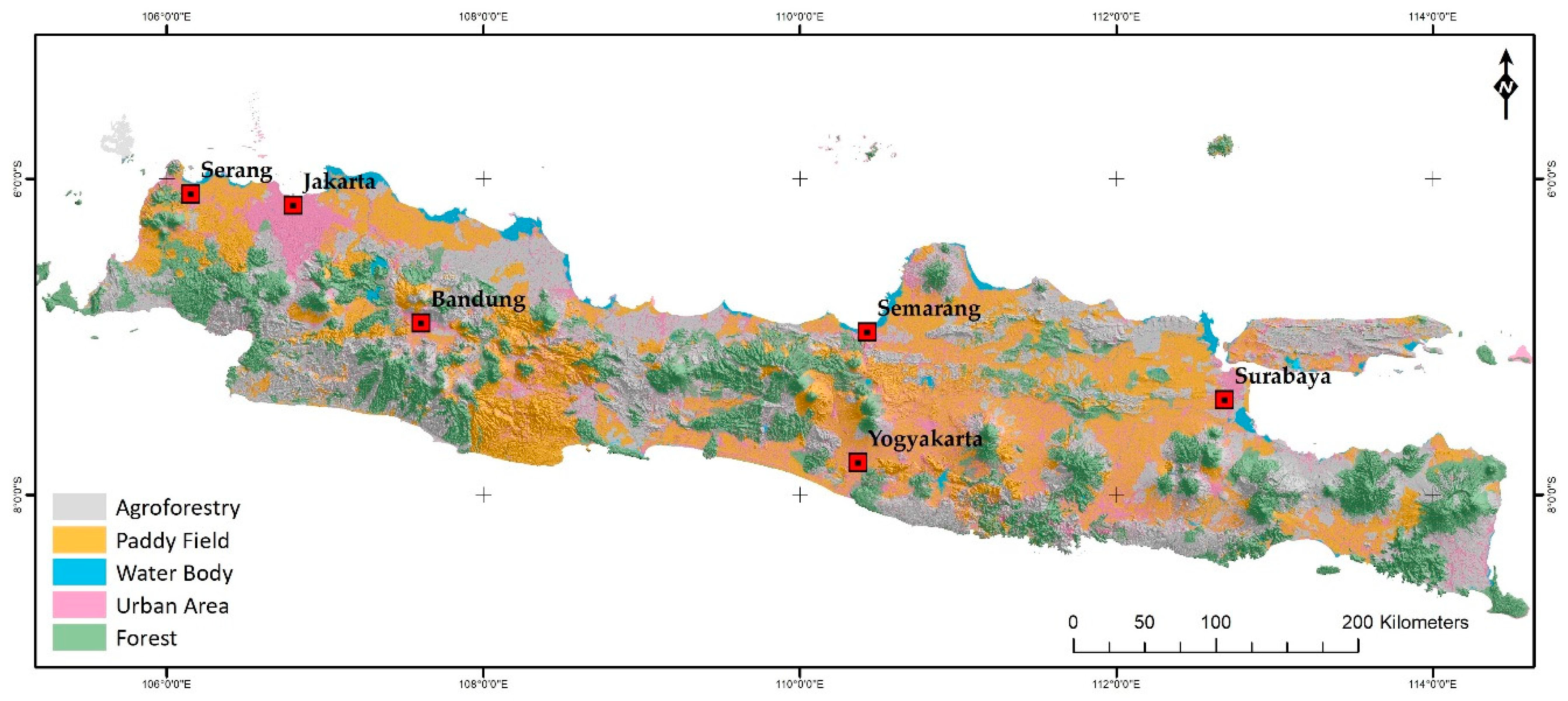
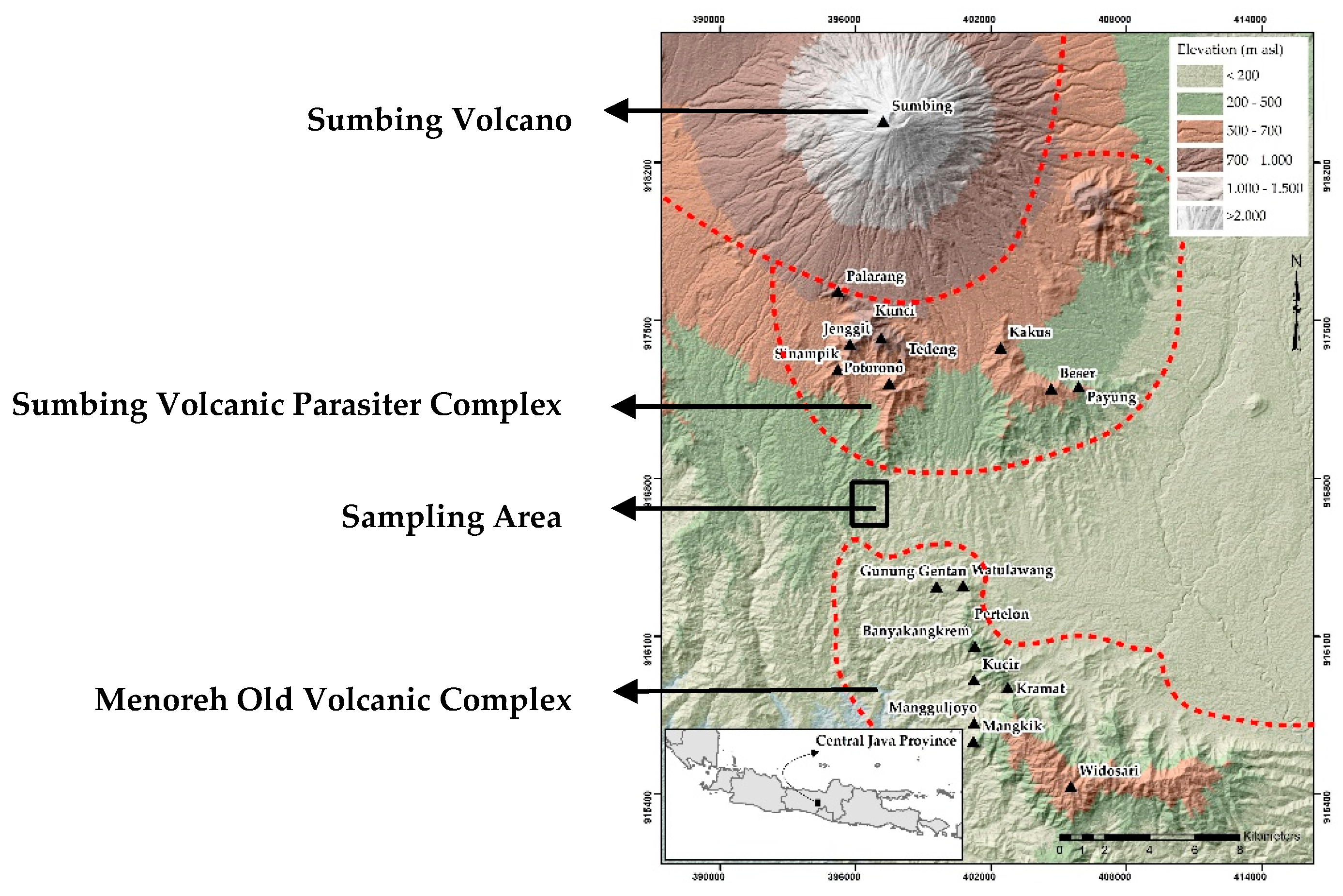
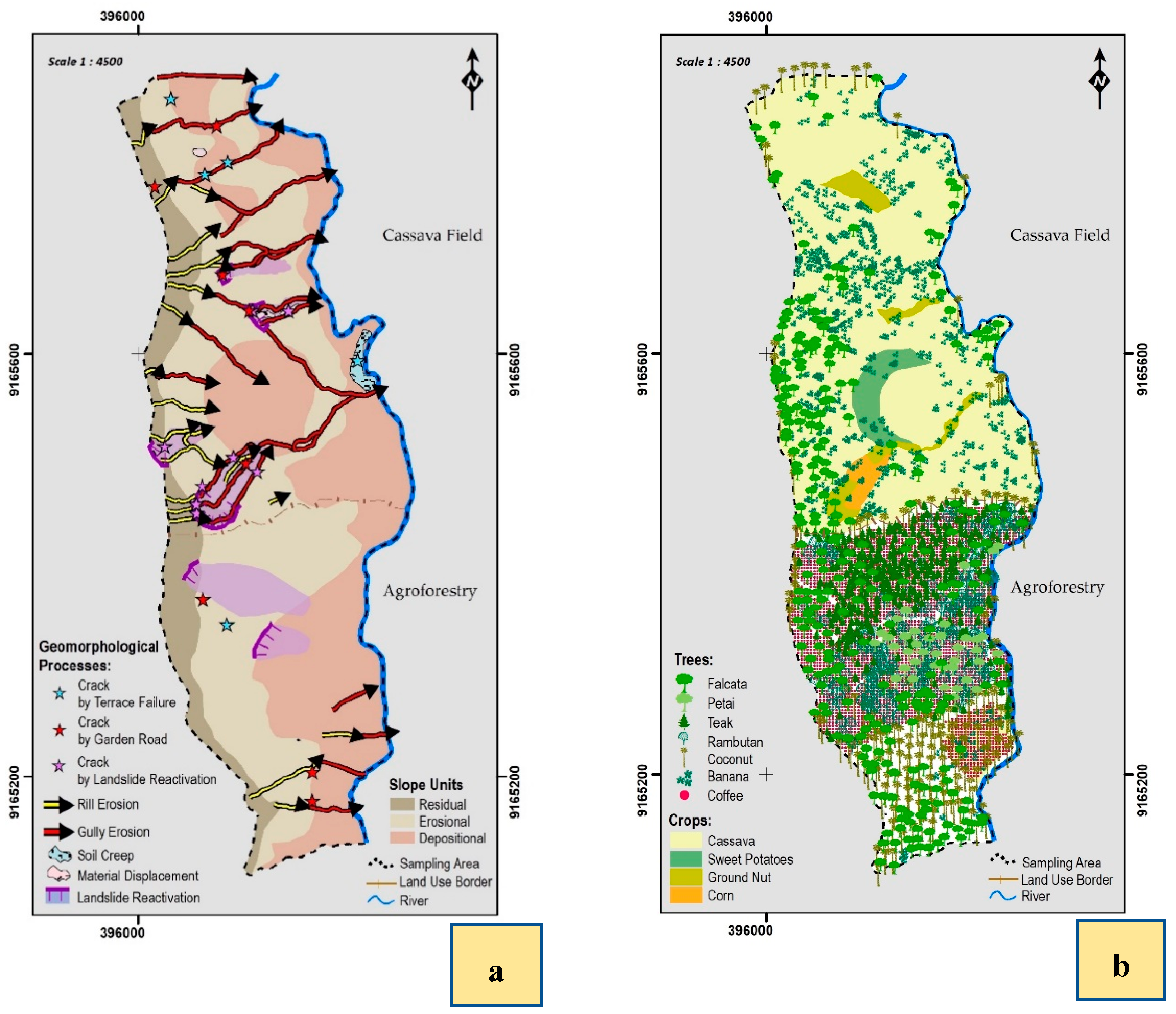
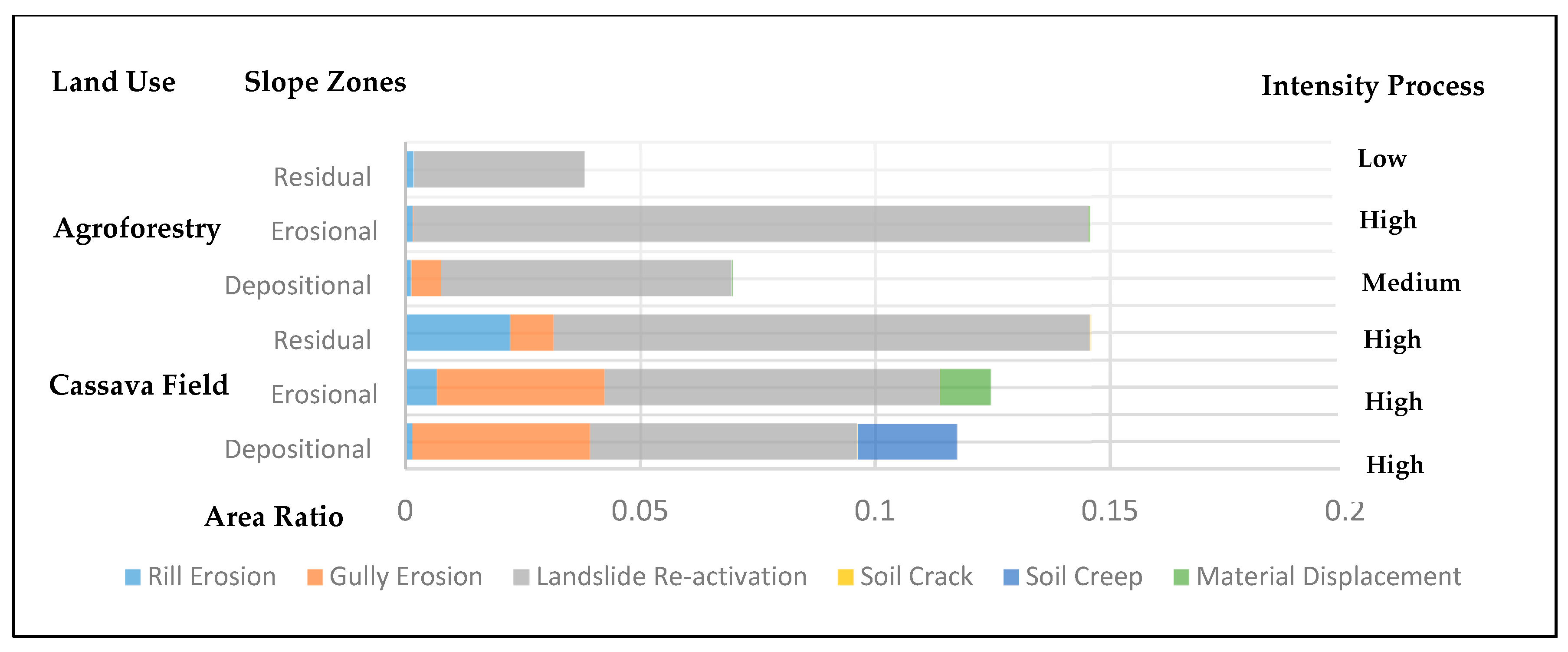
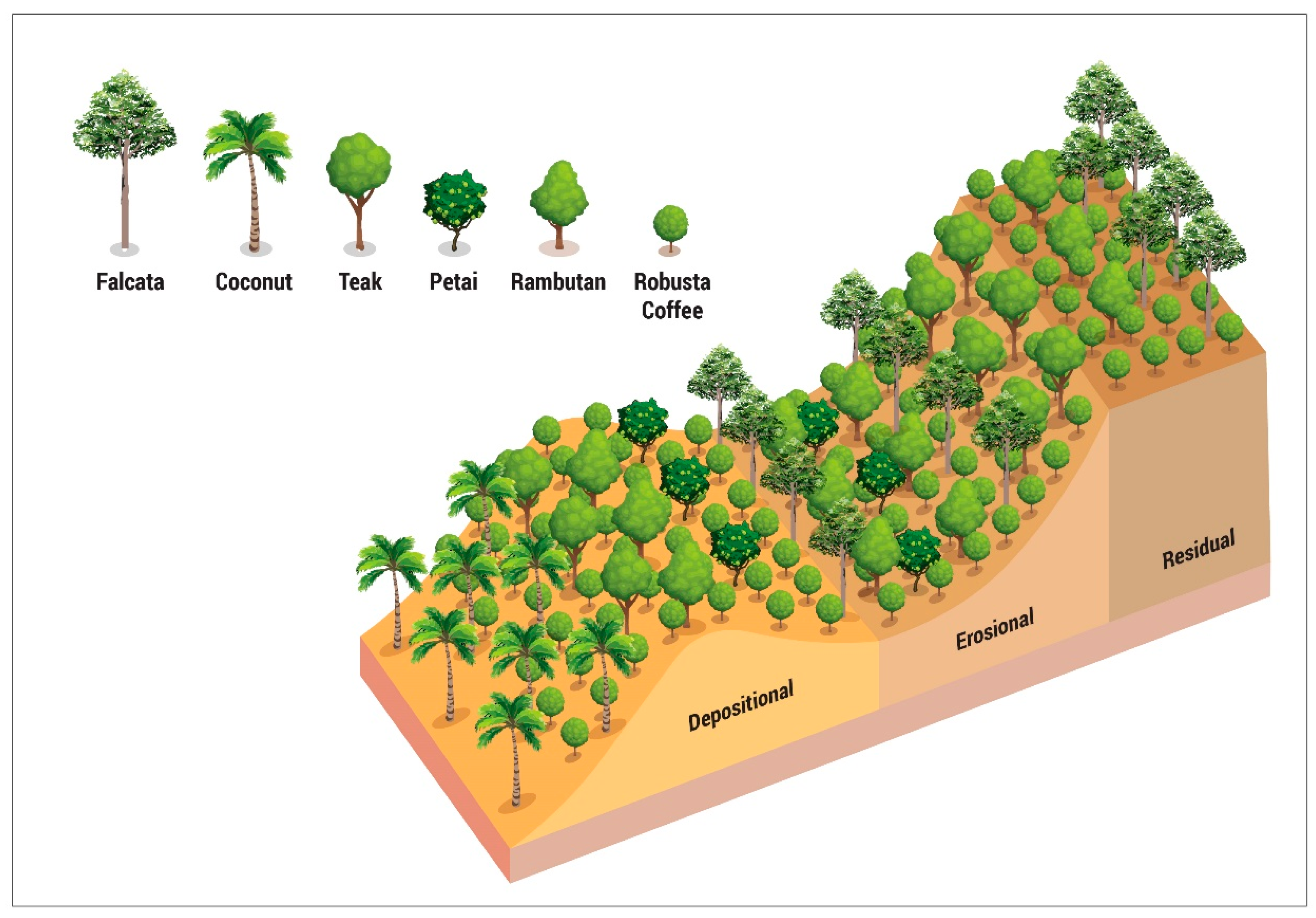
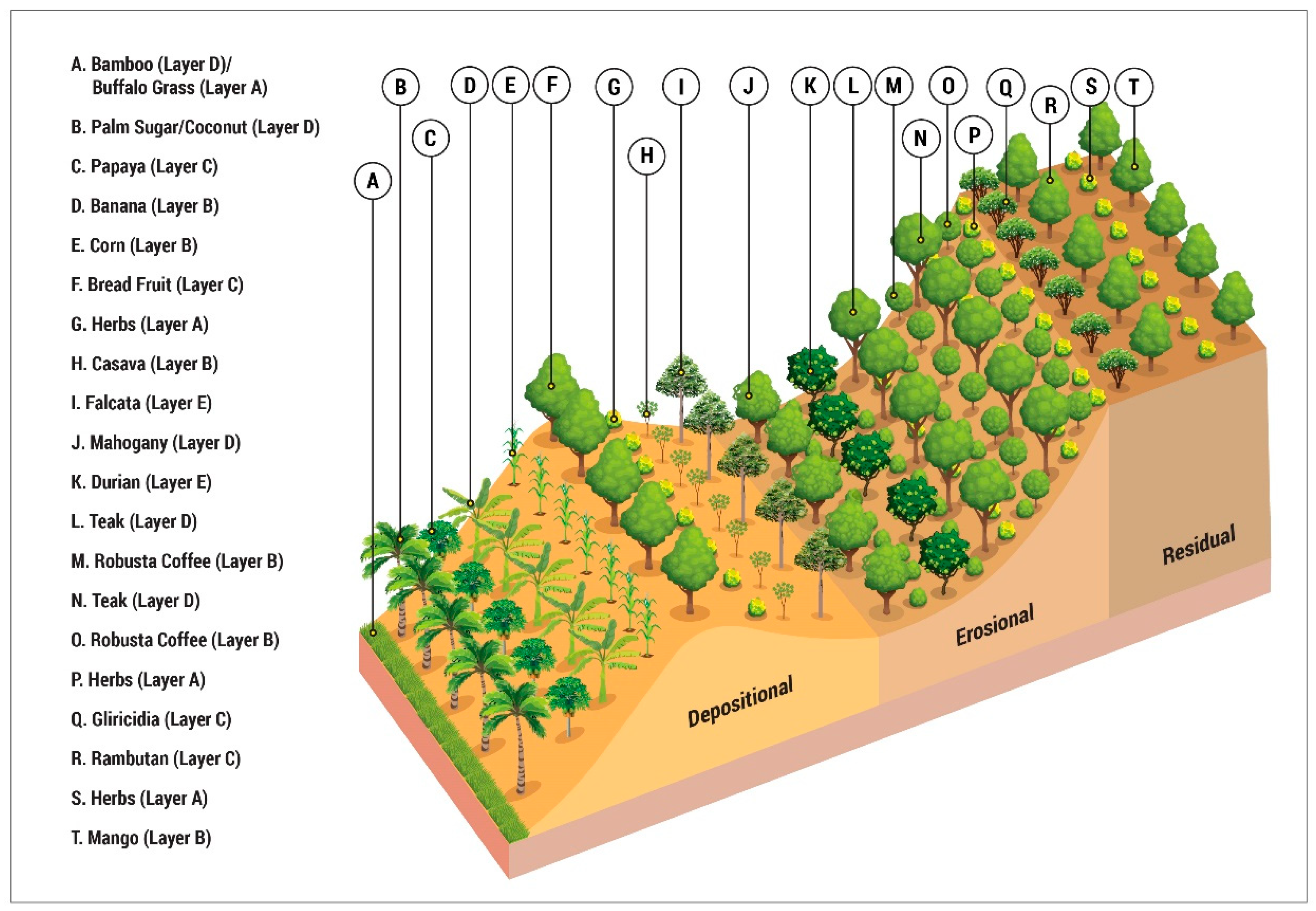
| Land Use | Slope Zones | Relative Position at the Landslide | Slope Length (m) | Slope Width (m) | % Area Coverage |
|---|---|---|---|---|---|
| Agroforestry | Residual | Upper | 38 | 352 | 12.37 |
| Erosional | Middle | 156 | 359 | 45.91 | |
| Depositional | Lower | 124 | 346 | 41.70 | |
| Cassava Field | Residual | Upper | 32 | 432 | 12.28 |
| Erosional | Middle | 120 | 443 | 47.08 | |
| Depositional | Lower | 48 | 442 | 40.62 |
| (a) | ||||||||||||
| Land Use | Slope Zones | ∑Falcata | ∑Coconut | ∑Petai | ∑Teak | ∑Rambutan | ∑Bamboo | ∑Banana | ∑Coffee | Total Number of Trees | Trees Density | Canopy Cover Per Zone Area (%) |
| Agroforestry | Residual | 38 | 23 | 0 | 13 | 10 | 0 | 0 | 486 | 570 | 0.0844 | 79 |
| Erosional | 67 | 64 | 5 | 238 | 69 | 0 | 7 | 1952 | 2402 | 0.0959 | 84 | |
| Depositional | 55 | 78 | 33 | 41 | 104 | 7 | 41 | 1666 | 2025 | 0.0890 | 80 | |
| Sub-Total | 160 | 165 | 38 | 292 | 183 | 7 | 48 | 4104 | 4997 | 0.0916 | 81 | |
| Cassava Field | Residual | 40 | 16 | 0 | 0 | 0 | 0 | 92 | 0 | 148 | 0.0157 | 28 |
| Erosional | 53 | 5 | 0 | 0 | 0 | 0 | 360 | 0 | 418 | 0.0116 | 11 | |
| Depositional | 22 | 11 | 0 | 0 | 0 | 5 | 257 | 0 | 295 | 0.0095 | 10 | |
| Sub-Total | 115 | 32 | 0 | 0 | 0 | 5 | 709 | 0 | 861 | 0.0113 | 13 | |
| (b) | ||||||||||||
| Land Use | Slope Zones | ∑Cassava | ∑Sweet Potatoes | ∑Corn | ∑Ground Nut | Total Number of Crops | Crops Density | Canopy Cover Per Zone Area (%) | ||||
| Agroforestry | Residual | 0 | 0 | 0 | 0 | 0 | 0.0000 | 0 | ||||
| Erosional | 24 | 0 | 0 | 0 | 24 | 0.0010 | 0 | |||||
| Depositional | 3040 | 0 | 0 | 0 | 3040 | 0.1337 | 7 | |||||
| Sub-Total | 3064 | 0 | 0 | 0 | 3064 | 0.0562 | 3 | |||||
| Cassava Field | Residual | 8889 | 0 | 0 | 125 | 9014 | 0.9590 | 47 | ||||
| Erosional | 33,942 | 0 | 840 | 306 | 35,088 | 0.9745 | 59 | |||||
| Depositional | 26,452 | 11,172 | 314 | 392 | 38,330 | 1.2335 | 66 | |||||
| Sub-Total | 69,283 | 11,172 | 1154 | 823 | 82,432 | 1.0778 | 60 | |||||
| No | Slope Zone Location | Layer Class Position | Plants Name | Plant’s Morphology | Ecological Function | Economy Function | |||||||||
|---|---|---|---|---|---|---|---|---|---|---|---|---|---|---|---|
| Height (m) | Canopy Shape | Stem Diameter (cm) | Stem Straightness | Root | Leaf Shape | Leaf Size (L × W cm) | Soil Conservation | Water Conservation | Environmental Adaptation | Economy Value | Harvest Age | ||||
| 1 | R/E/D | A | Galangal (Kaempferia galanga) | 0.05 | Bush | - | Clumps | Rhizome | Oval | 10 × 5 | Ground base cover crop | Reducing runoff velocity | Shade-resistant | Seasonal crop | 6–12 months |
| 2 | R/E/D | A | Ginger Zerumbet (Zingiber zerumbet) | 1 | Bush | 5 | Clumps | Rhizome | Oval | 30 × 5 | Ground base cover crop | Reducing runoff velocity | Shade-resistant | Seasonal crop | 10 months |
| 3 | R/E/D | A | Curcuma (Curcuma zanthorrhiza) | 1 | Bush | 5 | Clumps | Rhizome | Oval | 50 × 20 | Ground base cover crop | Reducing runoff velocity | Shade-resistant | Seasonal crop | 9–10 months |
| 4 | R/E/D | A | Turmeric (Curcuma longa) | 1 | Bush | 5 | Clumps | Rhizome | Oval | 50 × 20 | Ground base cover crop | Reducing runoff velocity | Shade-resistant | Seasonal crop | 11–12 months |
| 5 | R/E/D | A | Galangal (Alpinia galanga) | 1 | Bush | 5 | Clumps | Rhizome | Oval | 40 × 10 | Ground base cover crop | Reducing runoff velocity | Shade-resistant | Seasonal crop | 10–12 months |
| 6 | R/E/D | A | Ginger (Zingiber officinale) | 1 | Bush | 5 | Clumps | Rhizome | Pinnate | 15 × 10 | Ground base cover crop | Reducing runoff velocity | Shade-resistant | Seasonal crop | 8 months |
| 7 | R/E/D | B | Robusta Coffee (Coffea robusta) | 5 | Oval | 5–10 | Shrubs | Tap roots | Oval | 20 × 5 | Medium ground cover crop | Reducing runoff velocity | Perennial crop | 3 months | |
| 8 | R | A | Pineapple (Ananas comusus) | 1 | Bush | - | Clumps | Fibrous roots | Pinnate | 150 × 7 | Ground base cover crop | Reducing runoff velocity | Seasonal crop | 24 months | |
| 9 | R | C | Gamal (Gliricidia sepium | 6 | Oval | 5–30 | Branchy | Tap roots | Pinnate | 6 × 10 | Wind breaker, Medium ground cover crop | Dry-resistant plant | Perennial crop | 3–4 months | |
| 10 | R | C | Water Apple (Syzygium aqueum | 10 | Dome | 50–70 | Branchy | Tap roots | Oval | 10 × 6 | Medium ground cover crop | Perennial crop | 3–4 years | ||
| 11 | R | C | Avocado (Persea americana) | 10 | Dome | 50–70 | Branchy | Tap roots | Oval | 15 × 5 | Medium ground cover crop | Perennial crop | 5–10 years | ||
| 12 | R | C | Mango (Mangifera indica) | 10 | Dome | 50–70 | Branchy | Tap roots | Oval | 20 × 10 | Medium ground cover crop | Perennial crop | 3–4 years | ||
| 13 | R | C | Rambutan (Nephelium lappaceum) | 14 | Dome | 25–30 | Branchy | Tap roots | Elliptic | 10 × 5 | Medium ground cover crop | Adaptable | Perennial crop | 6–7 years | |
| 14 | E | C | Langsat (Lansium parasiticum) | 15 | Oval | 50–70 | Branchy | Tap roots | Pinnate compound | 10 × 5 | High ground cover crop | Perennial crop | 8–12 years | ||
| 15 | E | C | Mangosteen (Garcinia mangostana) | 15 | Dome | 50–70 | Tap roots | Elliptic | High ground cover crop | Perennial crop | 5 years | ||||
| 16 | E | D | Jengkol (Archidendron pauciflorum) | 20 | Dome | Straight | Tap roots | Compound | 15 × 10 | High ground cover crop | Perennial crop | 4 years | |||
| 17 | E | D | Gnetum (Gnetum gnemon) | 20 | Oval | 10–20 | Straight | Tap roots | Elliptic | 10 × 5 | High ground cover crop | Dry plants | Perennial crop | 5–7 years | |
| 18 | E | D | Jackfruit (Artocarpus heterophyllus) | 20 | Dome | 30–100 | Straight | Tap roots | Elliptic | 15 × 5 | High ground cover crop | Perennial crop | 5–10 years | ||
| 19 | E | D | Teak (Tectona Grandis) | 20 | Oval | 50–150 | Straight | Tap roots | Rounded | 30 × 20 | High ground cover crop | Deciduous during dry season | Dry plants | Perennial crop | 20–80 years |
| 20 | E | D | Duku (Lancium domesticum) | 20 | Oval | Branchy | Tap roots | Pinnate compound | 15 × 5 | High ground cover crop | Shade-resistant | Perennial crop | 15 years | ||
| 21 | E | D | Mahogany (Swietenia mahagoni) | 20 | Dome | 120 | Straight | Tap roots | Rounded compound | 8 × 4 | High ground cover crop | Perennial crop | 10 years | ||
| 22 | E | E | Durian (Durio zibethinus) | 35 | Dome | 70–100 | Branchy | Tap roots | Oval | 20 × 10 | High ground cover crop | Good planted in thick soil | Perennial crop | 8–15 years | |
| 23 | D | A | Ground Nut (Arachis hypogaea) | 0.25 | Bush | 1 | Clumps | Tap Roots | Compound | 5 × 2 | Ground base cover crop, nitrogen fixing | Reducing runoff velocity | Seasonal crop | 3 months | |
| 24 | D | A | Sweet Potatoes (Ipomoea batatas) | 0.3 | Bush | 1 | Clumps | Tuber | Fig leaf | 4 × 3 | Ground base cover crop | Reducing runoff velocity | Seasonal crop | 3–4 months | |
| 25 | D | A | Grass (Panicum muticum) | 1 | Bush | 3 | Clumps | Fibrous roots | Pinnate | 100 × 5 | Ground base cover crop | Reducing runoff velocity | Wet plants | Seasonal crop | 25–30 days |
| 26 | D | B | Corn (Zea mays) | 2 | Shrub | 5 | Straight | Fibrous roots | Pinnate | 30 × 10 | Ground base cover crop | Seasonal crop | 3 months | ||
| 27 | D | B | Banana (Musa spp.) | 2 | Rounded | 30 | Straight | Fibrous roots | Long oval | 120 × 50 | Medium ground cover crop, Soil moisture balancer | Soil water extraction | Seasonal crop | 12 months | |
| 28 | D | B | Cassava (Manihot utilissima) | 2 | Shrub | 3 | Straight | Tuber | Fig leaf | 20 × 10 | Medium ground cover crop | Dry plants | Seasonal crop | 9–10 months | |
| 29 | D | B | Papaya (Carica papaya) | 5 | Rounded | 30–40 | Straight | Fibrous roots | Fig leaf | 50 × 70 | Medium ground cover crop | Wet plants | Seasonal crop | 8–9 months | |
| 30 | D | C | Breadfruit (Artocarpus altillis) | 13 | Dome | 50–70 | Branchy | Tap roots | Pinnate | 40 × 30 | Medium ground cover crop | Perennial crop | 4 years | ||
| 31 | D | C | Petai (Parkia speciosa) | 15 | Dome | 20 | Branchy | Tap roots | Pinnate compound | 0.1 × 0.05 | High ground cover crop | Wet plants | Perennial crop | 4–10 years | |
| 32 | D | D | Acacia (Acacia auriculiformis) | 17 | Dome | 10–20 | Straight | Tap roots | Pinnate compound | 10 × 2 | High ground cover crop | Perennial crop | 5 years | ||
| 33 | D | D | Bamboo (Dendrocalamus asper) | 20 | Oval | 12–20 | Straight | Fibrous roots | Pinnate | 25 × 5 | Holding soil, protecting riverbanks, preventing landslides, controlling erosion, Soil moisture balancer | Soil water extraction | Perennial crop | 3–6 years | |
| 34 | D | D | Sugar Palm (Arenga pinnata) | 25 | Palm | 65 | Straight | Fibrous roots | Pinnate | 8 × 5 | Holding soil, riverbanks preventing landslides, controlling erosion, Soil moisture balancer | Soil water extraction | Low evapotranspiration | Perennial crop | 6–12 years |
| 35 | D | E | Coconut (Cocos nucifera) | 30 | Palm | 30–40 | Straight | Fibrous roots | Pinnate | 10 × 5 | Holding soil, Soil moisture balancer | Soil water extraction | Good planted on flat land | Perennial crop | 5–10 years |
| 36 | R/D | E | Rosewood (Dalbergia latifolia) | 30 | Dome | 70–100 | Straight | Tap roots | Pinnate | 10 × 5 | High ground cover crop, Nitrogen fixing | Need good drainage | Perennial crop | 20–50 years | |
| 37 | D | E | Falcata (Albizia falcataria) | 35 | Dome | 70–100 | Straight | Tap roots | Pinnate compound | 0.1 × 0.05 | High ground cover crop, Nitrogen fixing | Perennial crop | 7 years | ||
© 2020 by the authors. Licensee MDPI, Basel, Switzerland. This article is an open access article distributed under the terms and conditions of the Creative Commons Attribution (CC BY) license (http://creativecommons.org/licenses/by/4.0/).
Share and Cite
Purwaningsih, R.; Sartohadi, J.; Setiawan, M.A. Trees and Crops Arrangement in the Agroforestry System Based on Slope Units to Control Landslide Reactivation on Volcanic Foot Slopes in Java, Indonesia. Land 2020, 9, 327. https://doi.org/10.3390/land9090327
Purwaningsih R, Sartohadi J, Setiawan MA. Trees and Crops Arrangement in the Agroforestry System Based on Slope Units to Control Landslide Reactivation on Volcanic Foot Slopes in Java, Indonesia. Land. 2020; 9(9):327. https://doi.org/10.3390/land9090327
Chicago/Turabian StylePurwaningsih, Rina, Junun Sartohadi, and Muhammad Anggri Setiawan. 2020. "Trees and Crops Arrangement in the Agroforestry System Based on Slope Units to Control Landslide Reactivation on Volcanic Foot Slopes in Java, Indonesia" Land 9, no. 9: 327. https://doi.org/10.3390/land9090327





